Power-horse Library
HELLO Dear ones
On this Account you will find all Study related Materials ,EXAMS, STUDY GUIDES, CASES,NOTEBOOKS and many more.
well come as we study for Excellency.
- 3622
- 0
- 255
Community
- Followers
- Following
22 Reviews received
3883 items
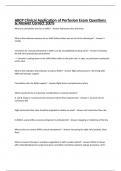
ABCP Clinical Application of Perfusion Exam Questions & Answer Correct 100%
What are cannulation sites for an LVAD? - Answer Pulmonary Vein and Aorta What is the minimum pressure for an LVAD inflow, before you are at risk for drawing air? - Answer 5 mmHg Correction for cannula entrapment in LVAD's can be accomplished by doing what? - Answer increasing the left atrial preload (decreasing flow) --> Cannula is sucking down in the LVAD inflow either in the pulm vein, lv apex, or just below crossing the aortic valve. What is the indication that indicates to add...
- Exam (elaborations)
- • 19 pages •
What are cannulation sites for an LVAD? - Answer Pulmonary Vein and Aorta What is the minimum pressure for an LVAD inflow, before you are at risk for drawing air? - Answer 5 mmHg Correction for cannula entrapment in LVAD's can be accomplished by doing what? - Answer increasing the left atrial preload (decreasing flow) --> Cannula is sucking down in the LVAD inflow either in the pulm vein, lv apex, or just below crossing the aortic valve. What is the indication that indicates to add...
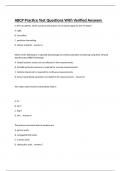
ABCP Practice Test Questions With Verified Answers
In 55% of patients, which coronary artery gives rise to blood supply for the S-A Node? A. right. B. circumflex. C. posterior descending. D. obtuse marginal. - Answer A Which of the following is a reported disadvantage of cerebral saturation monitoring using Near Infrared Spectroscopy (NIRS) Technology: A. Global ischemic events are not reflected in the measurements. B. Pulsatile perfusion pressure is required for accurate measurements. C. Catheter placement is required for continuous m...
- Exam (elaborations)
- • 18 pages •
In 55% of patients, which coronary artery gives rise to blood supply for the S-A Node? A. right. B. circumflex. C. posterior descending. D. obtuse marginal. - Answer A Which of the following is a reported disadvantage of cerebral saturation monitoring using Near Infrared Spectroscopy (NIRS) Technology: A. Global ischemic events are not reflected in the measurements. B. Pulsatile perfusion pressure is required for accurate measurements. C. Catheter placement is required for continuous m...
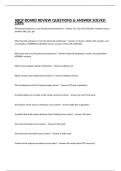
ABCP BOARD REVIEW QUESTIONS & ANSWER SOLVED 100%
What good substances cross the placental membrane? - Answer O2, CO2, H2O, bilirubin, maternal serum proteins, RBc, IgG, IgA What harmful substances cross the placental membrane? - Answer 1) viruses: rubella, HIV, measles, oral conraception, WARFARIN, DILANTIN, Xanax, cocaine, heroin, RH-antibodies What does not cross the placental membrane? - Answer maternal chplesterol, Insulin, Succinylcholine, HEPARIN, bacteria Which vessel supplies blood to the fetus? - Answer umbilical vein Whic...
- Exam (elaborations)
- • 185 pages •
What good substances cross the placental membrane? - Answer O2, CO2, H2O, bilirubin, maternal serum proteins, RBc, IgG, IgA What harmful substances cross the placental membrane? - Answer 1) viruses: rubella, HIV, measles, oral conraception, WARFARIN, DILANTIN, Xanax, cocaine, heroin, RH-antibodies What does not cross the placental membrane? - Answer maternal chplesterol, Insulin, Succinylcholine, HEPARIN, bacteria Which vessel supplies blood to the fetus? - Answer umbilical vein Whic...

PBSE Perfusion Practice Exam Questions & Answer Correct 100%
The major cation found in extracellular fluid is: - Answer Sodium (Na) The primary structural units of proteins are: - Answer L-amino acids Which clotting factor is activated by contact with foreign surfaces, roughened vascular walls, and platelet aggregates? - Answer 12 - Hageman (X11) The effect of plasmin is to: - Answer Limit clotting by splitting fibrin The normal arterio-venous oxygen difference is approximately: - Answer 5 volumes percent Oxygen delivery will be decreased w...
- Exam (elaborations)
- • 7 pages •
The major cation found in extracellular fluid is: - Answer Sodium (Na) The primary structural units of proteins are: - Answer L-amino acids Which clotting factor is activated by contact with foreign surfaces, roughened vascular walls, and platelet aggregates? - Answer 12 - Hageman (X11) The effect of plasmin is to: - Answer Limit clotting by splitting fibrin The normal arterio-venous oxygen difference is approximately: - Answer 5 volumes percent Oxygen delivery will be decreased w...
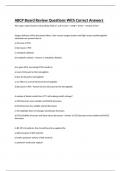
ABCP Board Review Questions With Correct Answers
The major cation found in extracellular fluid is? a) K+ b) Ca++ c) Mg++ d) Na+ - Answer d) Na+ Oxygen delivery will be decreased when a low venous oxygen tension and high venous oxyhemoglobin saturation are present due to: a) increase in P50 b) decrease in P50 c) metabolic alkalosis d) metabolic acidosis - Answer c) metabolic alkalosis At a given PO2, increasing PCO2 results in: a) more O2 bound to the hemoglobin b) less O2 bound to hemoglobin c) no effect on amt of O2 bound to hemo...
- Exam (elaborations)
- • 18 pages •
The major cation found in extracellular fluid is? a) K+ b) Ca++ c) Mg++ d) Na+ - Answer d) Na+ Oxygen delivery will be decreased when a low venous oxygen tension and high venous oxyhemoglobin saturation are present due to: a) increase in P50 b) decrease in P50 c) metabolic alkalosis d) metabolic acidosis - Answer c) metabolic alkalosis At a given PO2, increasing PCO2 results in: a) more O2 bound to the hemoglobin b) less O2 bound to hemoglobin c) no effect on amt of O2 bound to hemo...
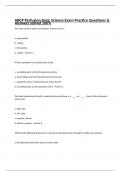
ABCP Perfusion Basic Science Exam Practice Questions & Answers Solved 100%
c.The most common type of anomalous venous return is: a. supracardiac b. cardiac infracardiac d. cardiac - Answer a A Pott's operation is an anastomosis of the: a. ascending aorta to the left pulmonary artery b. descending aorta to the pulmonary artery branch c. subclavian artery to the pulmonary artery branch d. ascending aorta to the subclavian artery - Answer a The basic hemodynamic fault in a patent ductus arteriosus is a ____ -to- _____ shunt at the pulmonary artery leve...
- Exam (elaborations)
- • 108 pages •
c.The most common type of anomalous venous return is: a. supracardiac b. cardiac infracardiac d. cardiac - Answer a A Pott's operation is an anastomosis of the: a. ascending aorta to the left pulmonary artery b. descending aorta to the pulmonary artery branch c. subclavian artery to the pulmonary artery branch d. ascending aorta to the subclavian artery - Answer a The basic hemodynamic fault in a patent ductus arteriosus is a ____ -to- _____ shunt at the pulmonary artery leve...
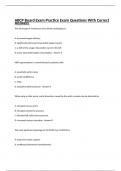
ABCP Board Exam Practice Exam Questions With Correct Answers
The advantage of continuous warm blood cardioplegia is: A: increased oxygen delivery B: significantly decreased myocardial oxygen tension C: a shift of the oxygen dissociation curve to the left D: lower myocardial oxygen consumption - Answer A IABP augmentation is contraindicated in patients with: A: prosthetic aortic valves B: aortic insufficiency C: VSDs D: peripheral atherosclerosis - Answer B When using a roller pump. aortic dissection caused by the aortic cannula may be de...
- Exam (elaborations)
- • 60 pages •
The advantage of continuous warm blood cardioplegia is: A: increased oxygen delivery B: significantly decreased myocardial oxygen tension C: a shift of the oxygen dissociation curve to the left D: lower myocardial oxygen consumption - Answer A IABP augmentation is contraindicated in patients with: A: prosthetic aortic valves B: aortic insufficiency C: VSDs D: peripheral atherosclerosis - Answer B When using a roller pump. aortic dissection caused by the aortic cannula may be de...
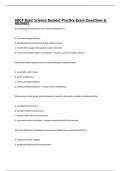
ABCP Basic Science Booklet Practice Exam Questions & Answers
An advantage of continuous warm blood cardioplegia is: A. Increased oxygen delivery B. Significantly decreased myocardial oxygen tension. C. A shift of the oxygen dissociation curve to the left. D. Lower myocardial oxygen consumption - Answer increased oxygen delivery Intra-aortic ballon augmentation is contraindicated in patients with: A. prosthetic aortic valves B. aortic insufficiency C. ventricular septal defects D. peripheral atherosclerosis - Answer aortic insufficiency W...
- Exam (elaborations)
- • 7 pages •
An advantage of continuous warm blood cardioplegia is: A. Increased oxygen delivery B. Significantly decreased myocardial oxygen tension. C. A shift of the oxygen dissociation curve to the left. D. Lower myocardial oxygen consumption - Answer increased oxygen delivery Intra-aortic ballon augmentation is contraindicated in patients with: A. prosthetic aortic valves B. aortic insufficiency C. ventricular septal defects D. peripheral atherosclerosis - Answer aortic insufficiency W...
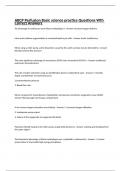
ABCP Perfusion Basic science practice Questions Wth Correct Answers
An advantage of continuous warm blood cardioplegia is - Answer Increased oxygen delivery Intra-aortic balloon augmentation is contraindicated in pts with - Answer Aortic insufficiency When using a roller pump, aortic dissection caused by the aortic cannula may be detected by - Answer Elevated arterial line pressure The most significant advantage of venovenous ECMO over venoarterial ECMO is - Answer Unaffected pulmonary hemodynamics The rate of water extraction using an ultrafiltratio...
- Exam (elaborations)
- • 13 pages •
An advantage of continuous warm blood cardioplegia is - Answer Increased oxygen delivery Intra-aortic balloon augmentation is contraindicated in pts with - Answer Aortic insufficiency When using a roller pump, aortic dissection caused by the aortic cannula may be detected by - Answer Elevated arterial line pressure The most significant advantage of venovenous ECMO over venoarterial ECMO is - Answer Unaffected pulmonary hemodynamics The rate of water extraction using an ultrafiltratio...
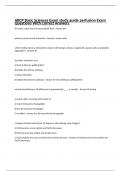
ABCP Basic Sciences Exam study guide perfusion Exam Questions With Correct Answers
the major cation found in extracellular fluid - Answer Na+ the eprimary structural unit of proteins - Answer L-amino acids which clotting factor is activated by contact with foreign surfaces, roughened vascular walls, and platelet aggregates? - Answer XII ffect of plasmin is to: A) limit clotting by splitting fibrin B) initiate the intrinsic pathway C) cleave thrombin D) initiate the extrensic pathway - Answer A) limit clotting by splitting fibrin normal arterio0venous O2 differe...
- Exam (elaborations)
- • 35 pages •
the major cation found in extracellular fluid - Answer Na+ the eprimary structural unit of proteins - Answer L-amino acids which clotting factor is activated by contact with foreign surfaces, roughened vascular walls, and platelet aggregates? - Answer XII ffect of plasmin is to: A) limit clotting by splitting fibrin B) initiate the intrinsic pathway C) cleave thrombin D) initiate the extrensic pathway - Answer A) limit clotting by splitting fibrin normal arterio0venous O2 differe...

LOUISIANA CLAIM ADJUSTER SERIES 204 HOMEOWNER INSURANCE EXAM SOLVED 100%
State Of Texas Security officer Level 2 non-commissioned Exam Questions With Correct Answers
State of Texas Security Level II Certification Questions With Correct Answers
MACS 609 CERTIFICATION EXAM QUESTIONS & ANSWERS CORRECT 100%
Michigan Builders License Exam Questions With Correct Answers